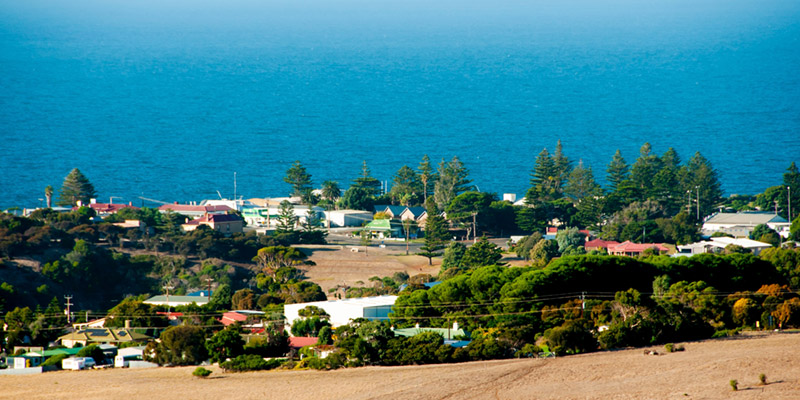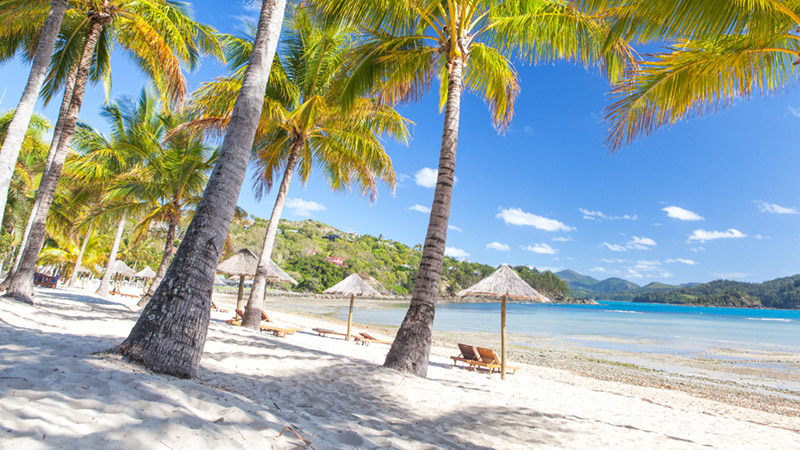Island real estate resisting wider property price pressures
As mainland property prices decline around Australia, islands are presenting property investment and lifestyle opportunities that are proving irresistible to many buyers.
While the geography and level of development on the 8,222 islands around Australia varies widely, the property market for island real estate has essentially remained uniformly solid in the face of rising interest rates.
From the country’s second largest island, South Australia’s Kangaroo Island, to tiny islands housing little more than a tin shed, prices have often soared in the past five years and proven more resilient than the mainland over the past 12 months.
The Covid pandemic certainly added some allure to the idea of an island escape and the shift in how Australians work continues to drive the heightened interest in island property.
Richard Vanhoff, an island and resort specialist for Private Islands Online Australia who lived on Hamilton Island, Queensland, for 18 years, has an intimate understanding of island property markets.
Speaking to API Magazine, Mr Vanhoff said residential islands have largely remained steady in the past year, while a lack of commercial development in the past ten years has sellers “asking what they like.”
“Islands are still holding their own but it also depends on what the island is, or is used for.
“If we take a leased island that has a residential entity, which is the case for 95 per cent of islands in Queensland, then this has remained the same price over the last year or so.
“For an island purchased in 2018 for $1 million, the asking price would now be around $1.8 million.
“Most owners have and will receive a better sales price in 2023 than their original purchase price in 2018.
“I can’t see that changing for any residential zoned island but I also can’t see that there is too much further growth for the moment.”
Island investment potential
It was, however, a different story for leased islands with commercial zoning for a resort-style operation.
“In that case, there is a new rule that can be applied; “ask what you like, within reason, of course.
“There was a hiatus in the last 10 years on development of new resorts - there just was not the appetite for commercially granted islands.
“In the last 10 years we have seen the demise of some major island resorts, such as South Molle, Hook, Lindeman and Brampton, Great Keppel, Double Island, and Keswick Island, as well as the freehold Dunk Island.
“For whatever the reason, these once iconic islands have been swaying in the palms with no guests or business.”
“In the last six months, however, there has been a rush on these once operational holiday destination islands.
“We have seen the sale of Dunk, Hook, Lindeman and Lizard Island.
“Of these islands that have recently changed hands, they have been sold to Australians; each of these islands have given the holding owner a fantastic return on investment, so it shows that the market for Australian islands is getting ready for the next wave of Australian and international island visitation,” Mr Vanhoff said.
Islands in Australia have sold for as little as $300,000 in the past 12 months, while others are on the market for $15 million and more.
Liam Kearney, Sales Agent for Hamilton Island Real Estate, said whole-of-island sales are usually commercial purchases, but for residential buyers on established islands, rental yields and investment potential were high.
“Generally speaking, we have not seen weakness in property prices on Hamilton Island because our owners and buyers tend to view real estate here from a rental yield or investment perspective, where they can generate returns of up to 5 to 7 per cent,” he said.
“Many also tend to view Hamilton Island real estate as an asset held for lifestyle reasons, and tend to be relatively less geared.”
Kangaroo Island bouncing back
This time three years ago, more than half of Kangaroo Island’s 4,416 square kilometres was engulfed in an inferno sparked by lightning strikes.
Today, the island’s wildlife, landscape and economy are rebounding strongly.
While it may seem counterintuitive, the bushfires ignited international interest in Kangaroo Island (KI) brought about by the global news coverage.
Lynne Savage, Principal, Kangaroo Island Real Estate, told API Magazine that the real estate market had lain dormant for about 10 years prior to the wildfires of 2019/2020 but that all changed very quickly.
“The media coverage that KI obtained at that time gave us an identity all over the world – it gained us better recognition that any tourism advertising campaign had ever achieved.
“The phones went crazy while the fires were still burning and all agents here were selling to people from all over Australia and in fact the world, often to people who had never even been here.
“On the back of the fires came Covid and the interest of new investors and indeed residents was insatiable.
“KI, like other islands, was seen as a safe haven due to its remoteness.
“Also, at that time, businesses were restructuring and having their staff work from home and many of the people now working from home realised they could have a sea-change while still working.

The township of Penneshaw, Kangaroo Island
“KI has an older population demographic, however, this is now changing with more and more young people in their 20s and 30s choosing island life.”
But like the wider national property market, interest rates fuelled by seemingly unstoppable inflation are dampening some of this enthusiasm.
“Prices have dipped slightly but the more obvious negative affect is the volume of enquiries for properties here and the much longer time frame to sell,” Ms Savage said.
“Interestingly, lots of residential parcels of land are being listed at present, rather than dwellings.
“From first application to build a new dwelling, it could be two to three years prior to completion of a new build, so this could be partly the reason that people with vacant land are deciding to sell, rather than waiting to build.
“We did have a healthy supply of listings of all property types during 2021 and 2022, but the number of listings has seriously declined since about September, which I believe is driven pretty much 100 per cent by rising interest rates.”
Whitsundays in demand
The Whitsunday property market is shaping up as the one to watch this year as southern buyers continue to flock to the Whitsundays, cementing its position as one of Australia’s key lifestyle markets.
Most of the 74 Whitsunday islands are uninhabited but Whitsunday, Hook, Hayman, Hamilton and Daydream islands are household names on the Australian travel scene.
Rob Taylor, Principal of Taylors Property Specialists, said the Christmas and New Year period had shown a continued strong demand from southern states for properties in the Whitsunday region.
“We’ve seen steady demand for property from southern buyers who have identified the Whitsundays as a key lifestyle market, especially blue chip locations such as Hamilton Island.”
“With growth in the state’s south-east coupled with limited stock due to rising construction costs, demand is outstripping supply and attention has turned to markets further north, especially among lifestyle buyers.”
Mr Taylor believes that the lifestyle markets such as the Whitsundays will continue to perform really strong despite headwinds from inflation and interest rates.
“Talk of interest rates potentially stabilising in the coming months will add to this, however, what we are finding is these southern lifestyle buyers don’t seem to be as greatly impacted by these rate increases.”
Supply bigger issue than interest rates
The lesser impact of interest rates on island property markets compared to the mainland was a view shared by Mr Vanhoff.
“Enquiries I am receiving for residential islands are from people who have ridden the Covid wave and worked out that they can conduct their business away from the office or home,” he said.
“Interest rates may have played a part earlier last year, however, the average purchaser’s profile is that they are fairly independent financially, and generally do not need finance.
“Supply is a big problem, as there are only so many islands and only a handful of residential islands are available at any one time.”
On Hamilton Island, properties have sold within a couple of days of hitting the market due to the lack of available properties for sale, according to Mr Kearney.
“The market for real estate at Hamilton Island has been mostly driven by available supply in recent years.
“We have limited properties available at any given time, and when certain properties come to market there is often a waitlist of buyers.
“One example is a villa at the Hamilton Island Yacht Club that recently sold in less that 48 hours.
“Of course interest rates do play some role for financial investors, but interest rates are not a major factor in driving the the island market.”
Island logistics
While buying an island or an island home sounds glamorous, Mr Vanhoff said properties were often very rudimentary and provision of essential services a priority.
“Not all islands are typical of the palm trees and the white sandy shores we see in movies and magazines.”
“The accommodation could be an old packing shed to a modern brick home, or in some cases an innocuous Colourbond shed on the outside with modern fittings and furniture on the inside, including air-conditioning.
“All islands require utility services like water, power and sewerage and in today’s utility market, it is easier to generate electricity either from solar or wind generation and effective sewerage control via bio’ units that convert the effluent into grey water for the gardens and absorption lines for the black water.
“Fresh water is obtained from the roofs of the buildings into storage tanks or via the aquifer from beneath the surface of the island, and nearly all islands have an aquifer of fresh water.”
Based on his 20 years in the business of selling islands and island property, Mr Vanhoff said the owners would on average hold the property for about five years.

Catseye Beach in the Whitsundays
“No two buyers are the same, they all have different ideas and requirements for an island,” he said.
“For instance, if we are looking for a resort style island for a client, there is generally a representative of a corporation with board members, company executives, accountants, and lawyers.
“Then there is the residential island buyer with a penchant for all things modern but basic accommodation, or the buyer that wants to have a pseudo island life with the ability to get there quickly and enjoy the facilities that can jointly be utilised by other owners on the island, such as on Hamilton Island or Great Keppel Island.
“I think the time is excellent for island property investment right now, as opposed to mainland housing that looks like losing a bit of its puff.”




















